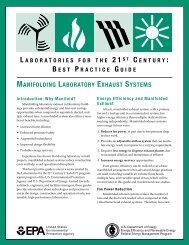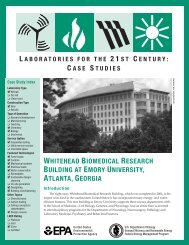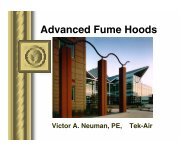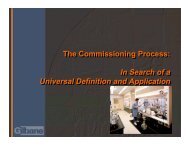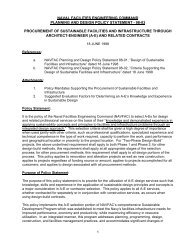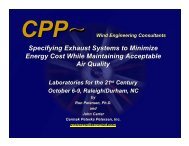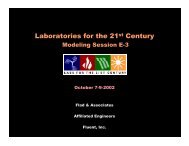Labs21: Optimizing Laboratory Ventilation Design - Labs21 ...
Labs21: Optimizing Laboratory Ventilation Design - Labs21 ...
Labs21: Optimizing Laboratory Ventilation Design - Labs21 ...
You also want an ePaper? Increase the reach of your titles
YUMPU automatically turns print PDFs into web optimized ePapers that Google loves.
Labs 21 Phone Forum<br />
<strong>Optimizing</strong> <strong>Laboratory</strong> <strong>Ventilation</strong> <strong>Design</strong><br />
with:<br />
Arlen Li, Payette Associates<br />
Gary Cabo, Payette Associates<br />
David Pinto, RG Vanderweil<br />
Bill Smeaton, Rowan Williams Davies & Irwin<br />
Duncan Phillips, Rowan Williams Davies & Irwin<br />
Charlotte Matthews, Steven Winters Associates, Inc.<br />
Moderated by:<br />
Paul Matthew, Lawrence Berkeley National <strong>Laboratory</strong>
Princeton University<br />
Guyot Hall Addition<br />
and Alterations<br />
Project<br />
Arlen Li, Associate Principal<br />
Director of <strong>Laboratory</strong> Planning, Payette Associates<br />
Gary Cabo, Associate Principal, Payette Associates<br />
Payette Associates<br />
Labs 21 Phone Forum - August 2003
Project Team<br />
Boston<br />
Payette Associates, Inc.<br />
R.G. Vanderweil Engineers<br />
Simpson Gumpertz & Heger Inc.<br />
Berg Howland Associates<br />
Rowan Williams Davies & Irwin Inc.<br />
R.W. Sullivan Code Group<br />
Kalin Associates<br />
Payette Associates<br />
Princeton Guyot Hall Addition<br />
Labs 21 Phone Forum - August 2003
Environmental Sciences Building<br />
Size: 185,000 SF new and renovated<br />
Building program<br />
• Teaching labs<br />
• Research labs<br />
• Offices<br />
Three departments<br />
• Princeton Environmental Institute<br />
• Geosciences<br />
• Ecology and Evolutionary Biology<br />
Payette Associates<br />
Princeton Guyot Hall Addition<br />
Labs 21 Phone Forum - August 2003
Green or LEED?<br />
• Project’s prospective donor advocates<br />
“Green”<br />
• Building’s E.S. program<br />
advocates “Green”<br />
• If green, how green? (LEED)<br />
• University does not pursue LEED<br />
registration<br />
• University undertakes campus-wide<br />
environmental initiative<br />
LEED provided:<br />
• Client’s definition of “green”<br />
• Yardstick of defined goals<br />
LEED did not provide:<br />
• Goals and strategies for lab process<br />
loads<br />
Payette Associates<br />
Princeton Guyot Hall Addition<br />
Labs 21 Phone Forum - August 2003
Green Strategies<br />
• Recycled Content Materials<br />
• Low-toxicity materials<br />
– Alternatives to epoxy<br />
– Alternatives to VCT<br />
– Trespa composite material<br />
• Construction waste management<br />
• CO 2 sensors, HVAC and lighting in offices<br />
and labs on occupancy sensors<br />
• Daylight harvesting<br />
• Radiant atrium flooring<br />
• Green Roof<br />
• Reduction of Air Change Rates<br />
Payette Associates<br />
Princeton Guyot Hall Addition<br />
Labs 21 Phone Forum - August 2003
Air Change Rates - Guidelines<br />
ASHRAE 62-2001<br />
Source Budget Building <strong>Design</strong><br />
Princeton Guyot Hall Addition<br />
20 CFM/person = 3.6 ACH w/ 24 students & 10’ ceiling<br />
(University Labs).<br />
NFPA 45-2000 4 ACH Unoccupied, Occupied typically exceeds 8 ACH<br />
OSHA 1910.1450 – 1994<br />
Prudent Practices – 1995<br />
ASHRAE Applications - 2003<br />
4 to 12 ACH is normally adequate of local exhaust<br />
(fume hoods are used).<br />
6 to 12 ACH is normally adequate. Cooling may require higher<br />
rates.<br />
General Labs: 6 to 10 ACH normally adequate<br />
Animal: 15 ACH from NIH Guide<br />
BSL-1:<br />
BSL-2:<br />
Princeton University Standard = 10 Air Changes<br />
3 to 4 ACH commonly used<br />
6 to 15 ACH typical<br />
Payette Associates<br />
Labs 21 Phone Forum - August 2003
Air Change Rates – What the team found<br />
• No codes, just guidelines<br />
• No Standard Industry Practice<br />
• Questioned client’s standard for air change rates in laboratories<br />
• Higher Rates Alone DO NOT EQUAL Assured Effective <strong>Ventilation</strong><br />
Payette Associates<br />
Princeton Guyot Hall Addition<br />
Labs 21 Phone Forum - August 2003
Air Change Rates – <strong>Design</strong> Process<br />
• Baseline Criteria - Initial Model<br />
– Based on client standard of 10 Air Changes<br />
– Effectiveness<br />
– Layout<br />
• Intermediate Modeling<br />
– 6 Air Changes<br />
– Diffuser Locations<br />
– Effectiveness<br />
• Final Model<br />
– 8 Air Changes<br />
– Diffuser Locations<br />
– Effectiveness<br />
– Client Responsiveness<br />
Payette Associates<br />
Princeton Guyot Hall Addition<br />
Labs 21 Phone Forum - August 2003
Air Change Rates – <strong>Design</strong> Process<br />
• Success of CFD Model Process<br />
- Client’s Acceptance of Operating Standard<br />
8 Air Changes as Occupied Building Standard<br />
10 Air Changes for Emergency Use<br />
6 Air Changes for Unoccupied Mode<br />
• Cost and/or Savings?<br />
Princeton Guyot Hall Addition<br />
• For every air change rate that is reduced, the maximum fan energy that is saved is 3%:<br />
- 10 Air Changes to 8 Air Changes Resulted in 6% Savings of Supply and Exhaust<br />
Fan Energy<br />
- 10 Air Changes to 6 Air Changes Resulted in 12% Savings of Supply and Exhaust<br />
Fan Energy<br />
Payette Associates<br />
Labs 21 Phone Forum - August 2003
CFD Modeling of Lab Spaces:<br />
Case Study of Guyot Hall<br />
� Duncan Phillips, Ph.D., P.Eng. (Associate)<br />
dap@rwdi.com<br />
� Bill Smeaton, P.Eng. (Associate)<br />
whs@rwdi.com<br />
Rowan Williams Davies & Irwin<br />
Guelph, Ontario
Outline<br />
� What is CFD<br />
� The CFD Process/How it Works<br />
� What you get after running CFD<br />
� Types of CFD Modeling –<br />
Representing Turbulence<br />
� Two Examples<br />
Labs 21 Phone Forum - August 2003
What is CFD<br />
� CFD = Computational Fluid<br />
Dynamics<br />
� The standard conservation<br />
equations for mass, momentum and<br />
energy along with others<br />
representing turbulence, humidity<br />
and contaminants are solved for<br />
discrete volumes in space.<br />
Labs 21 Phone Forum - August 2003
CFD Modeling Methodology<br />
� Need to define objective - what is to be<br />
assessed:<br />
� Fume hood containment challenges<br />
� Energy efficiency<br />
� Thermal comfort<br />
� Spill scenario<br />
� The objectives will steer the modeling<br />
decisions and in some cases in result in<br />
different approaches<br />
Labs 21 Phone Forum - August 2003
The CFD Process<br />
� Define the region to be modeled<br />
and divide it into smaller volumes<br />
called cells - gridding<br />
� Apply conservation equations to<br />
each cell<br />
� Ensure each cell knows about its<br />
neighbors<br />
� Solve conservation equations<br />
Labs 21 Phone Forum - August 2003
How CFD Works<br />
U(x)<br />
A(x)<br />
T(x)<br />
&Q<br />
P(x) P(x + *x)<br />
&E<br />
U(x + *x)<br />
A(x + *x)<br />
T(x + *x)<br />
� One uses CFD to predict flow field<br />
properties by solving the Navier<br />
Stokes Equations<br />
&W<br />
Labs 21 Phone Forum - August 2003
What you get After Running CFD<br />
� The solution for a simulation in a typical<br />
laboratory generates a set of data for<br />
pressure, air speeds, temperature,<br />
turbulence quantities, and contaminant<br />
concentrations.<br />
� These variables can be further analyzed<br />
to generate information such as<br />
fumehood capture challenges, occupant<br />
comfort, age of air/ventilation efficiency.<br />
Labs 21 Phone Forum - August 2003
Types of CFD Modeling<br />
For our purposes this is associated with<br />
the method by which turbulence is<br />
handled and whether the results<br />
represent steady or transient conditions<br />
DNS – Direct Numerical Simulation<br />
LES – Large Eddy Simulation<br />
RANS – Reynolds Averaged Navier Stokes<br />
Turbulence and the effects it causes<br />
represents one of the major<br />
uncertainties in CFD modeling<br />
Labs 21 Phone Forum - August 2003
Turbulence – Why Worry?<br />
� Turbulence is observed in most natural and<br />
engineering flows<br />
� Turbulence is responsible for:<br />
� Increased heat transfer<br />
� Increased drag losses<br />
� Increased pollutant release from surfaces<br />
� Increased dispersion/transport of heat and<br />
contaminants about a space<br />
� These effects can cause contaminants to<br />
escape from a fumehood and be rapidly<br />
transported about a lab<br />
Labs 21 Phone Forum - August 2003
Turbulence Mechanisms<br />
Oranges<br />
Grapefruit<br />
� Turbulent motion transporting packets of<br />
“information” – temperature, momentum,<br />
contaminants<br />
Labs 21 Phone Forum - August 2003
Including the Effects of Turbulence<br />
in a CFD Model<br />
� DNS – Direct Numerical Simulation<br />
� Currently unrealistic<br />
� LES – Large Eddy Simulation<br />
� Gaining momentum<br />
� RANS – Reynolds Averaged Navier Stokes<br />
� Current method of choice<br />
Labs 21 Phone Forum - August 2003
Examples of CFD Modelling in<br />
Labs<br />
� Guyot Hall Lab <strong>Ventilation</strong> (RANS)<br />
� Thermal Comfort<br />
� Energy Costs<br />
� Spill Scenario<br />
� Industrial Lab <strong>Ventilation</strong> (RANS & LES)<br />
� Diffuser selection and effects at face of<br />
fumehood – 3 scenarios<br />
� Assessment of fumehood containment<br />
challenges<br />
Labs 21 Phone Forum - August 2003
Guyot Hall Teaching Lab -<br />
Geometry Figure 1<br />
Labs 21 Phone Forum - August 2003
Guyot Hall Teaching Lab – Result<br />
� The purpose of the simulation was to<br />
assess the lower ventilation rate<br />
Figure 2<br />
Labs 21 Phone Forum - August 2003
Guyot Hall Research Lab –<br />
Geometry Figure 3<br />
Labs 21 Phone Forum - August 2003
Guyot Hall Research Lab – Results<br />
Figure 4 Figure 5<br />
Animation 1 Animation 2<br />
Labs 21 Phone Forum - August 2003
Industrial Lab – RANS Model<br />
Figure 6<br />
Labs 21 Phone Forum - August 2003
Industrial Lab – RANS Result<br />
Figure 7<br />
Animation 3<br />
Animation 4<br />
Labs 21 Phone Forum - August 2003
Industrial Lab – LES Result<br />
LES Animation 5<br />
LES Animation 6<br />
Figure 8a<br />
Figure 8c<br />
Figure 8b<br />
Labs 21 Phone Forum - August 2003
Conclusions<br />
� We have shown<br />
� CFD modeling is a valuable tool that<br />
designers and engineers can use to<br />
evaluate designs.<br />
� It permits one to compare and optimize<br />
alternatives.<br />
� Poor application of the technique can result<br />
in incorrect answers.<br />
� For Guyot Hall and the Industrial Lab<br />
application, use of CFD permitted the team<br />
to enhance the design for the client, reduce<br />
costs and evaluate risks<br />
Labs 21 Phone Forum - August 2003
Where do we go from here?<br />
• How do we apply knowledge in next project?<br />
• How does a designer take stock in results seen in CFD Modeling?<br />
• How do we intend to use CFD Modeling in the future?<br />
• CFD Modeling as Performance Illustration for Compliance<br />
• Ultimate Goal:<br />
To provide a safe environment in laboratories while using less energy.<br />
Labs 21 Phone Forum - August 2003




